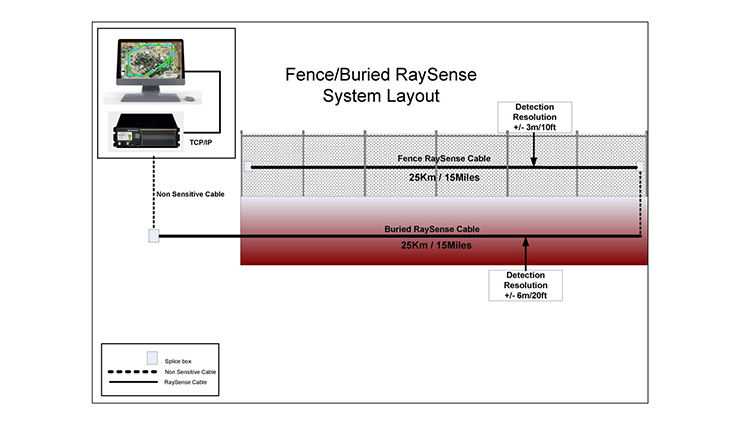The Ultimate Overview to Fiber Optic Security Systems for Your Service
In an era where safety concerns are critical for companies, comprehending the complexities of fiber optic modern technology can be transformative. This overview lays out exactly how integrating fiber optic safety and security systems not just enhances information defense yet also provides benefits like resistance to disturbance and real-time surveillance capacities. As organizations review their safety needs, it ends up being essential to consider the installment process and the most up to date advancements in the area. What certain variables should be focused on when picking the appropriate system, and how can services guarantee they make the most educated options?
Comprehending Fiber Optic Modern Technology

The core of a fiber optic cable television is composed of a thin glass or plastic facility, surrounded by a cladding layer that reflects light back right into the core. Single-mode fibers are created for long-distance transmission, while multi-mode fibers are appropriate for much shorter ranges, usually used within structures.
Fiber optics are not just faster but also more protected than standard electrical wiring. Their integral resistance to electro-magnetic disturbance and the difficulty of using the signal without detection make them a preferred choice for businesses focusing on data honesty and safety. As organizations progressively depend on safe and secure and reliable communication systems, understanding fiber optic modern technology comes to be essential for informed decision-making.
Trick Benefits of Fiber Optic Safety
When considering protection options for a service, the advantages of fiber optic systems are specifically compelling. Firstly, fiber optic modern technology provides phenomenal data transmission rates and bandwidth ability, making it ideal for dealing with high-resolution video feeds from monitoring cams. This ability guarantees that protection personnel get real-time information, improving total response times to possible protection risks.
Additionally, fiber optic cable televisions are naturally resistant to electromagnetic interference, which can compromise the honesty of conventional copper-based systems. This resistance makes sure that the information sent continues to be safe and secure and undisturbed, providing a much more reputable protection infrastructure. Additionally, fiber optics are much less susceptible to physical damage, as they are made from glass instead than metal, reducing maintenance prices and downtime.
Fiber optic systems use improved cybersecurity functions, including encryption capabilities that safeguard delicate information this from unapproved gain access to. Jointly, these advantages make fiber optic security systems a robust option for organizations looking for to enhance their safety actions.
Installment Process and Considerations
Taking into consideration the intricacies entailed, the setup procedure of fiber optic security systems calls for careful planning and implementation. The initial step includes an extensive website evaluation to recognize optimal locations for cabling and tools. This analysis must consider ecological elements, existing facilities, and potential susceptabilities.

In addition, the setup needs to comply with neighborhood building ordinance and industry requirements. This may include collaborating with different stakeholders such as building managers, IT groups, and security employees to make sure smooth integration with existing systems.
Post-installation, rigorous testing is essential to validate system efficiency and determine any problems that might emerge. By prioritizing these factors to consider during the installment process, companies can make sure a durable and effective fiber optic safety and security system that meets their certain safety and security demands.
Most Recent Advancements in Fiber Optic Safety
Current innovations in fiber optic modern technology have actually dramatically boosted the capabilities of safety systems for businesses. Among one of the most notable technologies is the assimilation of fiber optic sensing units that can detect vibrations and breaches along the border of a facility. These sensors provide real-time surveillance, enabling quick feedback to possible violations.
In addition, the growth of dispersed fiber optic noticing technology allows for the continuous surveillance of large locations with a single fiber cable. This method not just minimizes setup prices however additionally enhances the integrity of keeping track of systems by eliminating the requirement for multiple, separate sensing units.
In addition, developments in multiplexing strategies have actually enabled businesses to transmit large quantities of information over fiber redirected here optic networks, improving the capabilities of video monitoring systems. High-def video feeds can currently be sent over cross countries without loss of high quality, ensuring that safety and security workers have accessibility to clear and actionable information.
Last but not least, using fabricated knowledge (AI) together with fiber optic systems is reinventing threat discovery. AI formulas can analyze data from fiber optic networks to identify uncommon patterns or actions, enabling positive safety and security measures. These innovations collectively stand for find more info a significant jump forward in fiber optic protection modern technology.
Picking the Right System for Your Service
Picking the appropriate fiber optic safety system for your service is critical for guaranteeing optimal security and satisfaction. To make an enlightened choice, assess your specific security needs, taking into consideration variables such as the dimension of your facilities, the nature of your procedures, and possible susceptabilities.
Begin by assessing the degree of safety required; for circumstances, risky atmospheres might demand advanced systems with incorporated monitoring and intrusion discovery capacities. Next off, consider scalability; as your company grows, your safety system should can increasing to accommodate raised needs without significant overhauls.
Furthermore, examine the integrity and efficiency of different systems. Look for companies with recognized track records and consumer reviews that vouch for their solution quality. It's also advisable to inquire about the technology's compatibility with existing facilities, ensuring a seamless assimilation process.
Verdict
In conclusion, fiber optic safety systems provide a robust solution for boosting service safety facilities. The most current innovations further bolster the effectiveness of these systems, making certain that businesses continue to be secure and versatile in an ever-evolving hazard landscape.